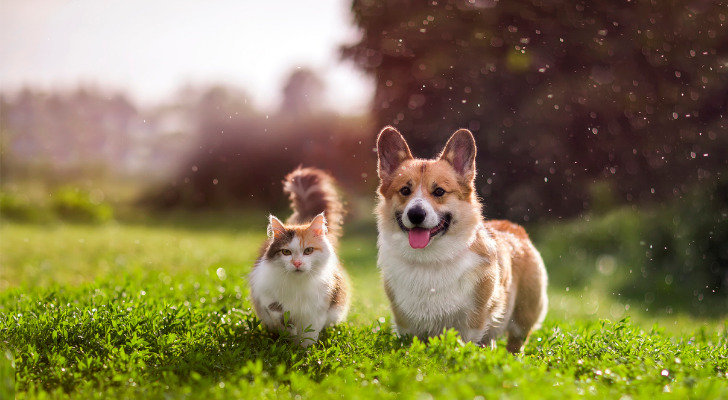When it comes to pets and estates, there are two main rules to understand. First – and sadly for the eccentric among us – you cannot leave money to your pet. The law says that animals are property, and one piece of property can’t own another. Little Chairman Meow cannot, unfortunately, inherit millions of dollars that the family will fight over for the rest of his nine lives. Instead, you will need what is known as a pet trust, which resembles other forms of property trusts. You create an account and, after your death, the trust’s administrator will use those funds to pay for your pet’s needs.
For help making sure your furry friends are taken care of after your death, consider working with a financial advisor.
What Is a Pet Trust?
A pet trust is a trust that provides money and care for your pets when you can no longer do so. The trust can operate either during your lifetime or after your death. While usually people create a pet trust as part of their estate planning, in some cases a pet trust can be useful if you’re incapacitated or otherwise unable to care for your pet.
Like all trusts, a pet trust is a legal entity that owns property, money and other assets. You fund the trust by contributing assets to it during your lifetime and by leaving assets to the trust in your will. Your pet is the beneficiary of this trust. Once the trust activates, the trustee in charge will use its funds to pay for your pet’s food, housing and other care. In most cases this means that someone has taken possession of your pet and the trust is reimbursing their costs.
If you want to make sure that your pet is well cared for after you die, most lawyers consider a pet trust better than a will. Pet trusts are more specific than just leaving your pet and some money to an heir. With a pet trust your trustee makes sure that this money really is spent on your pet’s well-being. They can also find a new home for your pet if your heir changes their mind and chooses not to inherit the animal.
Pet trusts can also get very detailed.
A pet trust does two main things. First, it provides the resources to care for your pets and other animals once you no longer can. Second, it provides the instructions to make sure those pets are cared for the right way. When you create a pet trust you can include instructions for how the trustee should care for your pet. This can range from medical treatment and food to specific housing requirements, daily routines and even preferred toys.
Pet trusts are similar, and often identical, to other forms of property trusts. For example you will often see families create a trust to care for a shared home, in which case the trust’s assets are used to pay for maintenance, upkeep and oversight of the house. A pet trust works the same way, except the trust’s assets pay for the care, housing and feeding of your pet.
The Three Types of Pet Trusts

Every state recognizes some form of pet trust, although the specific laws will differ in each jurisdiction. Broadly, there are three types of pet trusts that you can use:
Honorary
With an honorary pet trust you leave an amount of money to whoever will care for your pet after you die. This becomes a conditional bequest, meaning that the person only receives funds from this trust while they’re caring for your pet according to the trust’s instructions.
Due to popular fiction this is the most familiar type of pet trust, but it is also an antiquated format and disfavored by most courts today.
Traditional
With a traditional pet trust you leave your pet to someone in your will, just like with an honorary pet trust. However, there are no conditional bequests involved. Instead the trust has a trustee who regularly dispenses funds as necessary to care for the pet and meet the trust’s instructions. This is preferred to an honorary trust as it involves no ambiguity regarding the trust’s funds, although it can create problems if your named heir can’t or won’t accept possession of your pet when you die.
Statutory
With a statutory pet trust you leave your pet to the trust itself. The trustee arranges for the pet’s caretaker and dispenses funds as necessary to care for the pet and meet the trust’s instructions. This is preferred to traditional pet trusts, as it avoids any inheritance issues. Although you may name a specific caretaker in your trust’s instructions, the trustee can find an alternative home if that person can’t or won’t take possession of your pet.
How Do You Create a Pet Trust?
Structurally, you can create a pet trust the same way as any other ordinary trust. As noted above, it’s common for people to create this trust as part of their estate and fund it through their will. When doing so, there are a few details that you will want to make sure you address.
Named Animals
When you create your pet trust, be clear regarding which animals the trust will care for. Any animal not specifically named in the trust documents will not be included and will instead pass to your family through ordinary probate.
Funds
Funding a pet trust can be a problem for many families. If you leave too little money in the trust, it will run out during your pet’s lifetime. If that happens the trust will wind up and state law will govern what happens to your pet. If you leave too much money, your family may challenge the trust. While relatively rare, courts will reduce excessive funds left to a pet trust.
Trustee/Caretaker
Do not simply assume that someone will assume the role of trustee. Nor should you assume that someone will want to take possession of your pet. Make sure to ask the people you intend to name for those positions. If someone you trust wants to take your pet after you die, you can name them as both caretaker and trustee. Otherwise, you may want to name a professional trustee such as a lawyer or banker to oversee the trust. If you do name a professional trustee, make sure to contribute enough money to cover their costs, as they will bill the trust for their time.
Specific Instructions
If your pet has any specific needs, make sure to name them in the trust. Usually this will involve medical issues or important details for your pet’s comfort. Be careful not to get too specific here, though. If you get unnecessarily precise, people may disregard your instructions altogether which can create numerous issues.
Longevity
The main difference between a pet trust and an ordinary property trust is longevity. You cannot create an indefinite pet trust. Once the animal or animals named in the trust die, the trust will wind up. The trust cannot pass to the offspring of your pet, nor to any new animals other than the ones originally named when you created the trust. It’s a good idea to specify how you want the trust to wind up once your pet dies, and what you want the trust to do with any remaining money. This will prevent the state from distributing this money and will also help the trust survive potential challenges from your heirs.
The Bottom Line

A pet trust is a trust that you establish to pay for the care and housing of animals. It holds assets that you put into the trust, and may legally own the animal as well depending on the nature of the trust that you establish.
Trust Tips
- Pet trusts are established like any other trust fund, so let’s take a look at how that works.
- A financial advisor can help you make an estate plan that works for you. Finding a qualified financial advisor doesn’t have to be hard. SmartAsset’s free tool matches you with up to three financial advisors who serve your area, and you can interview your advisor matches at no cost to decide which one is right for you. If you’re ready to find an advisor who can help you achieve your financial goals, get started now.
Photo credit: ©iStock.com/Circle Creative Studio, ©iStock.com/Nataba, ©iStock.com/Pekic
